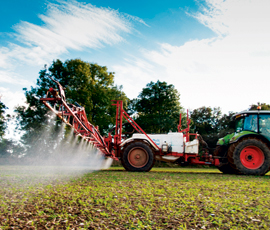How to protect your OSR crop from autumn diseases

Light leaf spot and restricting excess growth should be the focus for oilseed rape growers who have seen their crops grow rapidly in the warm and dry autumn.
Most crops have developed quickly after a frantic drilling season in late August, easing the risk of phoma for many and making light leaf spot the number one disease threat this year.
Warm, dry weather has pegged back the level of light leaf spot fungus, according to Neal Evans, European research lead at Weather Innovations, but he urges caution if it turns wet.
“The light leaf spot forecast doesn’t seem to show as much as we thought, although levels in the North and the South West are still quite high,” Dr Evans says.
Backward crops
Fellow plant pathologist Peter Gladders agrees that light leaf spot is on the increase and sees it as the biggest disease threat, although phoma will be a problem on backward crops.
“For these crops the number one priority will be phoma. The smaller the plant, the quicker the fungus can spread from the leaf petiole to the stem,” says Dr Gladders, from crop consultant ADAS.
In these backward crops, growth regulation is of less importance and Will Foss, regional technical advisor at Agrii suggests using prothioconazole with a lower rate tebuconazole or flusilazole.
“I’d follow-up these treatments with a combination of prothioconazole + tebuconazole four to six weeks later, or at disease reinfection stage, to target light leaf spot and phoma,” he adds.
Flusilazole is being withdrawn from the market and will not be available to buy after 12 October, although it can still be used for up to 12 months after that date.
Lincolnshire grower George Atkinson has yet to see any signs of phoma or light leaf spot, with blackgrass the main issue. However, PGRs will play a big role in his more forward crops.
Pest Control
- Above-average temperatures have increased insect activity this autumn.
- Most crops have signs of beetle feeding damage and aphid activity, with growers urged to be vigilant and ready to react quickly to any signs of damage.
“It’s a complete contrast to last year. I think 40% of our oilseed rape will be in the category of needing a good PGR,” he says.
Mr Atkinson says he is pleased with about 95% of his oilseed rape and plans to get two fungicide sprays on in late autumn and early winter.
Forward crops
Growers looking at well-established crops at the four to six true leaf stage may need early treatment to control growth and give some disease control, says Will Foss, regional technical adviser at distributor Agrii.
Mr Foss advises using the triazole fungicide metconazole to control growth and disease in the early part of the season, although this may mean spraying before the 10% phoma threshold.
For crops at the two to four leaf stage, he suggests a lower rate of metconazole, combined with a prothioconazole/tebuconazole mix or flusilazole to give good disease control and some plant growth regulator (PGR) activity.

